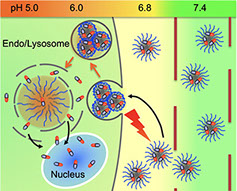Laboratory for Analytical Chemistry
Citterio Laboratory
Innovation of Chemical Sensors
Keio University
Faculty of Science and Technology
Department of Applied Chemistry

Stimuli-Responsive Polymers
Stimuli-responsive polymers are getting attention as next-generation medical materials because they are able to reversibly change their properties in response to external stimuli. We develop new stimuli-responsive polymers, especially those responding to changes in temperature or pH, and apply them to the medical field.
Thermo-responsive polymers
Hyperthermia, which is used for local heat treatment of cancer, provides higher therapeutic effects by combination with tumor-specific chemotherapy using thermo-responsive polymers. In this case, thermo-responsive polymers are required to be biocompatible and to show an accurate temperature response. We developed thermo-responsive polymers with high biocompatibility and a controlled response temperature close to body temperature.
pH-responsive polymer micelles
As cancer cells have a lower pH environment than normal cells, pH-responsive polymer micelles encapsulating fluorescent dyes release them selectively around cancer cells. This makes them a useful material for cancer selective fluorescent imaging. We developed pH-responsive polymer micelles with controlled pH response and succeeded in increasing the fluorescence intensity in the low pH environment.
pH-responsive mixed-charge polymers
As cell membranes have a phospholipid bilayer structure, the cell surface is negatively charged. Therefore, polymers that are positively charged in a low pH environment can selectively adsorb onto cancer cells. We developed polymers switching from a mixed charge to a positive charge state in response to low pH environment and succeeded in increasing their cell adhesion ability.
Other examples
In addition, we are developing a novel thermo-responsive polymer with high biocompatibility and hydrogels for cell separation technology.
For specific information, please refer to our list of publications.
Back
Citterio Laboratory 2023
Last update: February 16, 2023